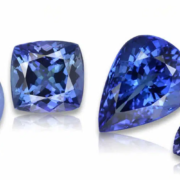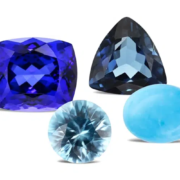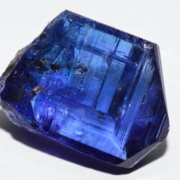Tanzanite stone – properties, virtues & benefits
The Tanzanite stone is a precious and rare gem found only in mines located in northern Tanzania. This stone is highly prized in jewelry because of its intense blue-violet color and its ability to change hue depending on the angle at which it is viewed. To find out more about this fascinating stone, including its history, sPiritual significance, properties and market value, read on.
TANZANITE CHARACTERISTICS
- Chakra: Throat.
- Properties: Protection, purification, emotional healing, communication, intuition.
- Astrology: Venus.
- Zodiac: Sagittarius.
- Elements: Fire, earth, air.
- Colors: Blue-violet, blue.
- Hardness: 6.5 – 7 on the Mohs scale.
- Chemical Formula: Ca2Al3(SiO4)3(OH).
- Associated god: /
TANZANITE – HIS HISTORY
Tanzanite stone takes its name from Tanzania, the country where it was discovered. This region is inhabited by the nomadic Maasai tribe, who live on the plains surrounding the extinct Kilimanjaro volcano. In the 1960s, a violent storm triggered bushfires in the Merelani hills, prompting the tribe to flee. On their return, they discovered brilliant blue stones, which were in fact gems transformed by the heat of the fire. The Maasai considered this a divine sign, as blue is a sacred color for them. Not knowing what the stone was, they commissioned a local explorer to find out. After analysis at the Gemological Institute of America (GIA), it turned out to be a class of zoïsite never seen before.
Zoïsite is a mineral introduced into mineralogical classification in 1805, but until then it had only been known in its brownish form. It was only when Tanzanian stones were exposed to high temperatures that they acquired their unique blue color. It was only a few years later that Tiffany & Co, the famous New York jeweler, fell in love with these stones and named them “tanzanites” in honor of their country of origin.
TANZANITE STONE – ITS ORIGIN AND COMPOSITION
Tanzanite is a transparent zoïsite, which belongs to the Silicate family and its scientific formula is Ca2 Al3 (SiO4)3 OH. Traces of chromium and vanadium in its composition naturally give it a range of colors from azure to violet. Its characteristic deep blue color comes from exposure to high temperatures. This stone was formed over 600 million years ago in schists, gneisses and amphibolites derived from the metamorphism of calcic rocks, as a result of volcanic activity in the Kilimanjaro mountain range. The gem’s hardness can vary from 6 to 6.5 on the Mohs scale, its density is between 3.15 and 3.37, and the main refractive indices are 1.685, 1.688 and 1.697. Tanzanite crystals vary in size and dimension, but gem weights generally do not exceed 100 grams.
Tanzanite doesn’t intrinsically fluoresce, but its particular brilliance comes from its ability to change color depending on the given orientation, which is called pleochroism. In the case of this stone, it’s even trichroism, meaning that the crystal displays three colors: blue, red-violet and brown-yellow-green (bronze). The intensity of each color depends on the angle at which the crystals are viewed. Being naturally endowed with these three colors, tanzanite is cut in a special way to highlight the blue color by diminishing the purple and violet components and accentuating the purity of the blue color, which is found in the most expensive gems.
There is also a multicolored variety of tanzanite called “fancy”, the most famous of which is called “chameleon” due to its ability to offer multicolored reflections. The high transparency and absence of inclusions are considered the “signature” of tanzanite stone.
Tanzanite is 1,000 times rarer than diamond, and is mined in only one place in the world. Although zoïsite can be found in countries such as Austria, Switzerland, Italy and the USA, there is only one tanzanite deposit, measuring just 20 km². This small harvesting area means that the estimated reserves are only 105 million carats, or a total weight of just 21 tonnes. Scientists estimate that these reserves will be exhausted in around twenty years.
Although French law considers only diamonds, sapphires, rubies and emeralds to be precious stones, tanzanite’s rarity and value make it a highly prized gem for jewelers and jewelry lovers the world over. The most famous tanzanite weighs 242 carats and is called the “Queen of Kilimanjaro”. It is set in a tiara adorned with 803 tsavorites and 913 diamonds, created by Tiffany Jewelry and now part of the private collection of Apple CEO Michael Scott.

TANZANITE STONE – VERTIES AND PROPERTIES
In lithotherapy, tanzanite is considered a precious mineral that is associated with creativity and imagination, making it an excellent ally for artists. This stone is said to enhance intellectual curiosity, artistic creativity, literary talent and humor. It is said to benefit sight and hearing and stimulate extrasensory perceptions and intuitive qualities, facilitating sPiritual research and meditation.
Tanzanite is associated with the astrological signs of Aquarius, Gemini, Aries, Pisces, but especially Capricorn, as it is the stone of December natives. It is also the symbol of the 24th wedding anniversary.
TANZANITE ON THE PSYCHOLOGICAL LEVEL
Tanzanite is considered beneficial on the sPiritual level, as it helps its wearer in their quest for greatness of soul and sPirit. It develops sensory perceptions and intuition, and is considered the mineral of sPiritual elevation, acting tactfully and gently to accompany the sPirit on the path to acquiring wisdom. There is a variety called “cat’s eye”, which is reputed for its ability to find light in darkness and is said to bring intuition and clairvoyance.
On the emotional level, it is considered the corollary of its action on the sPiritual level. It awakens the noblest feelings and idealistic asPirations. Artists find it particularly useful for its stimulating influence on imagination and creativity. It encourages the manifestation of art in all its forms, whether music, painting or literature. Synonymous with renewal, it pushes the individual to surpass himself and encourages him to move forward. It also stimulates curiosity and helps overcome insPiration blocks and memory loss.
Tanzanite reveals the noblest characteristics and asPirations of an individual’s personality. It is considered the mineral of self-fulfillment and selfless, idealistic dreams. It confers the strength to fight for one’s ideas and speak the truth in conflicting environments.
TANZANITE ON THE PHYSICAL LEVEL
Tanzanite is beneficial on the physical level as it can activate the brain and combat physical failures related to the senses such as sight and hearing. It is associated with the higher chakras, located at the throat, eyes and top of the head. As a mineral of renewal, it participates in the body’s regeneration by harmonizing various exchanges and promotes better irrigation of the nervous system.
Because of this regenerative feature, it is also said to have soothing properties for stomach aches such as stomach and digestion problems, as well as for the renal system. On the body level, the stone is said to act on the skeleton and skin, promoting cell regeneration.

TANZANITE STONE – CLEAN AND RECHARGE
To clean and recharge your Tanzanite stone, here are a few steps to follow:
Cleaning:
- Soak the stone in warm distilled water for a few minutes to remove any dust or surface dirt.
- Use a soft bristle brush to gently scrub the stone and remove all traces of dirt.
- Avoid using harsh detergents or aggressive chemicals that could damage the stone.
Loading:
- Place your Tanzanite stone in direct sunlight for a few hours to recharge.
- You can also place the stone on a cluster of crystals such as an amethyst or quartz geode to recharge it.
- Visualize pure white light filling your stone, purifying and recharging it with new positive energy.
Repeat these steps regularly to keep your Tanzanite stone clean and energized.
WHERE DOES THE NAME TANZANITE COME FROM?
The name Tanzanite was given to this stone in reference to its place of discovery, the East African country of Tanzania. Specifically, Tanzanite was discovered in 1967 in the Merelani mountains of northern Tanzania, near Mount Kilimanjaro. The name Tanzanite was proposed by Tiffany & Co, the famous American jeweller, who helped popularize the stone by giving it a distinctive trade name. Since then, the name Tanzanite has become synonymous with this fascinating and much-loved blue-violet stone.
WHICH CHAKRA DOES TANZANITE ACT ON?
Tanzanite is associated with the throat chakra, also known as the Vishuddha chakra in Sanskrit. The throat chakra is located at the level of the throat and is linked to communication, self-expression, creativity and listening. Tanzanite is considered a stone that can help balance and stimulate the throat chakra, promoting clearer communication and more authentic self-expression. It can also help heal emotional blockages that can prevent effective communication and creative expression.
WHICH ASTROLOGICAL SIGN IS ASSOCIATED WITH TANZANITE?
Tanzanite is primarily associated with the zodiac sign Sagittarius, which is generally considered to be born between November 22 and December 21.
TANZANITE STONE SUMMARY
Tanzanite is a relatively new gemstone, discovered in 1967 in the Merelani mountains of Tanzania. It is a variety of zoïsite, which owes its characteristic blue-violet color to the presence of vanadium and/or chromium in its composition.
Tanzanite is a relatively rare and expensive stone, due to its beauty and unique geographical origin. It is often cut in brilliant, oval or pear shapes to maximize its brilliance and color.
Tanzanite is also associated with healing and wellness properties, including communication, intuition and sPirituality. It is often used in jewelry for rings, necklaces and earrings, and is a popular stone for December birthday gifts.




